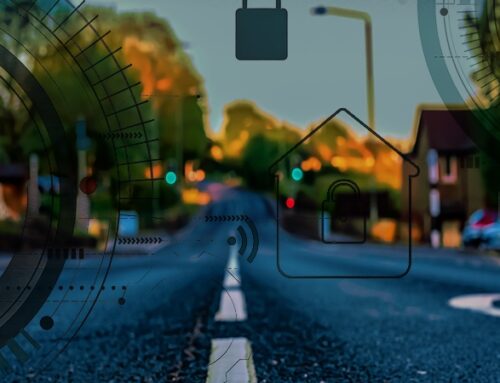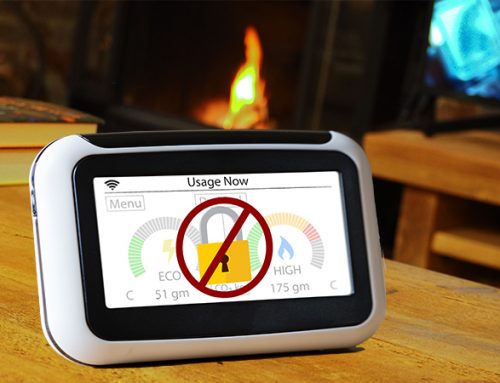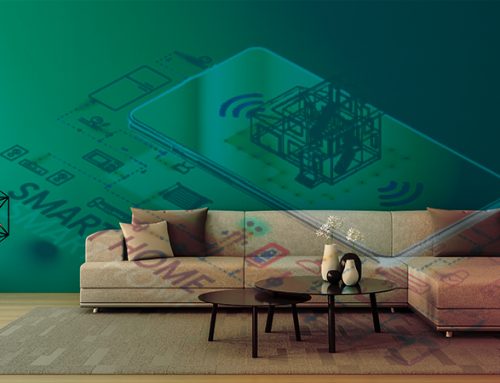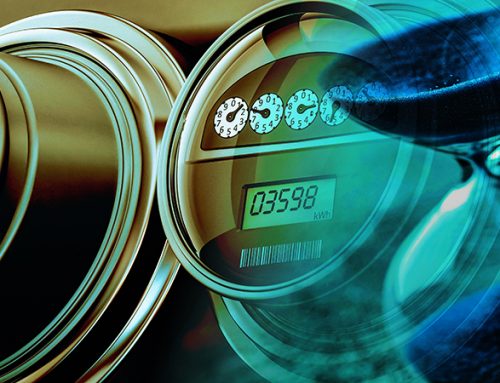When I decided to write about smart meters, I thought it would be fairly straightforward…explain what they are, why they are being introduced, what are the costs and benefits etc. What I have discovered is that the world is split into three groups…people like myself who hadn’t given the subject much thought and were therefore neutral, and then two opposing groups with massively polarised views, with “Smart Meters will Save the Planet” on one side battling against the “Smart Meters are a Stalinist Evil that Must be Stopped” on the other (with various colourful claims such as smart meters can cause your blood to curdle while setting fire to your home).
What I struggled to find was actual data.
Some history
The first known electricity meter was patented by Samuel Gardiner in 1872, and throughout the late 19th century various designs were proposed in order to measure and bill for the growing commercial use of electricity. The most common type of meter in use today is the electromechanical induction meter, which works by counting the revolutions of a non-magnetic metal disc which rotates at a speed which is proportional to the amount of power passing through the meter.
Radio activated meters have historically been common in the UK, in order to facilitate cheaper overnight tariffs eg Economy 7 which provided off-peak rates between midnight and 7am. The meters were activated by a radio signal carried within the longwave carrier of BBC Radio 4 (198 KHz) and it was common for households to charge storage heaters and heat water by immersion during the cheaper night-time period. These schemes fell in popularity as gas became cheaper and storage heaters were found to be complicated to use and inefficient.
The next generation
Among the major drawbacks of traditional electricity meters is that they only measure total consumption, and that they must be physically inspected in order to determine the exact amount of electricity used. This means that unless dual-tariff meters (such as were required for schemes such as Economy 7) were installed, it was not possible for utilities to use tariffs as a means of modulating consumer demand. It also meant that bills were often based on estimated readings, which has contributed to wide-spread consumer confusion around billing.
This has led to the development of smart meters which provide near-real time consumption data and can be combined with power monitoring systems to inform consumers not just about their overall consumption at different times of day, but also help them to understand how this consumption is broken down across their different appliances. The ultimate objectives are to improve consumer awareness of their consumption, and to support demand reduction strategies through adaptive pricing where tariffs vary depending on demand or the time of day.
The technical challenge
Smart meters carry out two primary functions: measuring consumption and communicating the data back to the energy suppliers, and communicating consumption data to consumers via an in-home display (“IHD”). The meters are therefore carrying out long-range data exchanges with utilities and short-range communications with IHDs.
Ideally in-home smart devices should use wireless transmitters that consume very little power, but with signal strength that can pass through walls and floors and even outside the property (meters are often located outside, or in cellars) without interfering with other networks.
Standard WiFi consumes a lot of power, so while it works well for high volume data streaming, it is not suitable for Internet of Things (“IoT”) devices, including smart meters. As a result, other technologies have evolved that use less power, and often also work in mesh configurations, to reduce point-to-point distances. There are four major protocols that work within the IEEE 802.15.4 standard for low-power, low-speed networks: Bluetooth LE, ZigBee, Z-Wave and Thread, however, they operate at different frequencies, and are largely incompatible with each other. Even devices developed on the same protocol are not always able to communicate, as different manufacturers adopt different implementations.
DECC has selected ZigBee as the wireless technology by which smart meters in the UK will communicate with in-home displays, because its mesh technology allows it to work over long distances and through thick walls which often separate meters from living areas. However, due to concerns that consumers may disconnect some of the mesh devices, a bespoke ZigBee specification has been developed for the UK which should have even longer range to reduce the need for nodes in the mesh.
Experience to date
The UK government has instigated a smart meter rollout with a target of reaching every home by 2020, at a projected cost of £11 billion, to be met through customer bills, with projected benefits of £17.1 billion. The question is whether the benefits will be achieved for the projected costs. Wide-scale smart meter programmes have been instigated in a number of countries, including Australia, Canada, New Zealand, the Netherlands, Italy and Spain, with mixed results.
An audit review of the programme in the Australian province of Victoria was carried out in 2011 and found that there would be no overall benefit to consumers, but instead a likely cost of $319 million. In a subsequent review carried out in 2015, the Auditor-General of Victoria found “a real risk that the expected benefits will not be achieved….and as costs are likely to increase over the life of the program, the final net cost to consumers is also likely to rise above $319 million.” His report also referenced market research carried out in 2014 which found that two-thirds of Victorians did not understand the benefits provided through smart meters, and many were unaware of their ability to help minimise energy bills.
In 2014 the Auditor-General of Ontario, Canada found that its scheme had gone two times over budget and had failed to meet targets for reducing peak electricity demand, in part because the difference between peak and off-peak rates had been too small.
In 2014 the EU carried out a review of the cost-benefit analyses of smart meters carried out by member states. The review did not opine on whether smart meters were cost effective or not, but analysed how individual states had arrived at their own conclusions and commented on the methodologies used. The review found that only 4 states (including the UK) believe smart meters to provide a positive benefit with 8 states believing that the costs outweighed the potential benefits, including Germany, which despite its famously green energy agenda has decided against a wide-scale smart meter programme.
Delivering the benefits
When considering the likely success of the UK rollout, it is worth bearing in mind the composition of domestic demand. The following chart illustrates that the largest single component of domestic power usage is lighting, followed by heating. These are not areas where changes in tariffs could be expected to create changes in usage by shifting consumption to other times of day – people will turn on the lights and the heating when it’s dark or cold, however there is scope for demand reduction through use of more energy efficient technologies.

Source: Elementenergy – Demand side response in the non-domestic sector – a report commissioned by Ofgem, July 2012
A review carried out by the University of Essex in 2015 found that there was little evidence to suggest that customers actually did reduce their consumption in response to more detailed usage data, with short-term reductions of only 2% being observed, which may not persist in the long term1.
Research carried out by the University of Bremen has suggested that rather than smoothing demand, adaptive pricing may actually cause “catastrophic synchronisation” whereby consumers with smart meters may, under certain conditions, start competing and create a new artificial market for electricity whose behaviour becomes very difficult to predict. Tariff variations that incentivise customers to shift demand to off-peak times, may result in demand that is difficult to manage as customers engage in “happy hour” behaviour, which could further be amplified by the use of programmable appliances able to respond to changes in prices2.
Other risks
The UK rollout faces a number of other risks.
- Interoperability: there is no industry-wide smart meter standard, which means that suppliers have each generated their own products and systems. There has been little interoperability between these to date, meaning that if customers switch provider their smart meters often revert to being dumb. These issues should be resolved when the centralised communications network operated by the Data and Communications Company goes live (planned for 2016).
- Obsolescence and technical reliability I: a recent report by the Computing Research found that “reasons holding back IoT are concerns about data security, the lack of a legal framework enforcing the protection of data and personal privacy, and the lack of any dominant communications protocols and standards”. Smart meters themselves can be considered part of the IoT, and the eventual aim of allowing consumers to adjust power usage through automation of for example lighting and heating controls which will rely on a wider IoT implementation in the home.The use of a GB-specific ZigBee standard presents risks, as the protocol may diverge from that developed by the ZigBee Alliance and may restrict the ability of ZigBee compatible devices to communicate with the IHDs as is already the case where utilities have created proprietary home hubs that are not plug-and-play with ZigBee home devices, let alone devices built on one of the many ZigBee alternatives. This is a real “Betamax” risk for early adopters.
- Obsolescence and technical reliability II: there are also concerns about the choice of technology for communications between meters and suppliers, which is currently specified as GPRS / SMS for two of the three regional Communication Service Providers contracts. This is problematic as the UK’s GPRS networks are scheduled to be turned off by 2026.
- Signal noise and interference: as the Internet of Things develops, the number wireless devices operating in the same spectrum will increase leading to noise (unwanted signals generated by electrical equipment) and interference (signals on nearby frequencies that disrupt transmission). This may mean some systems may not work as they should, and there may be signal leakage from nearby properties.
- European market harmonisation: the UK electricity market operated on the basis of 30-minute settlement periods, with many smart meters being designed on the basis of half-hourly recording. The EU has proposed reforms aimed at harmonising the UK market with the rest of Europe, which could mean that the settlement period would change to 15 minutes, rendering many existing smart meters inoperable.
- Privacy: this is not a UK-specific concern, but there are various potential issues around the privacy of consumer data, particularly around their usage habits. There are worries that as more and more appliances are connected to the internet, hackers will be able to gain access to people’s homes…while the benefits of hacking someone’s fridge remain to be seen, there are legitimate concerns around cyber security and the ability of hackers to potentially disrupt the supply and metering systems leading to fraudulent billings, theft of credit, or supply interruptions. Last year British Gas was forced to start encrypting data for its remote heating app after it was found that burglars could hack customer WiFi and access data to see when homes were unoccupied.
- Safety: alongside the usual concerns about the effects of electromagnetic radiation on human health, which are so far unproven, there have been some problems with the physical reliability of early smart meters, as seen in Ontario where 5,400 meters had to be removed due to instances of meters catching fire, and in the US where several hundred thousand smart meters have been replaced due to concerns over arcing leading to fires. So far this does not seem to have been a significant problem in the UK, but diligence is required in order to ensure appropriate electrical safety standards are maintained.
Conclusion
I think it’s safe to conclude that smart meters will neither save the planet nor cause Armageddon, and the real question is whether they present value for money. On balance I think the risks at this point probably outweigh the benefits, and there are cheaper alternatives to smart metering if the primary intention is to promote changes in consumer behaviour due to better consumption information.
Governments, particularly in the UK, have a poor track record of successfully delivering large IT projects, and the lack of technological maturity increases the threats to a durable implementation. There are significant risks that smart meters installed today will need to be replaced or upgraded ahead of their 12-15 year lifespan, eroding consumer value.
There are probably better uses for the £11 billion investment.
1 “The Question of Energy Reduction: The Problem(s) with Feedback,” by Kathryn Buchanan, et.al., Energy Policy, Volume 77, February 2015, Pages 89–96.
2 “Econophysics of adaptive power markets: When a market does not dampen fluctuations but amplifies them” by Sebastian M. Krause, Stefan Börries, and Stefan Bornholdt, Phys. Rev. E 92, 012815, 22 July 2015






Leave A Comment